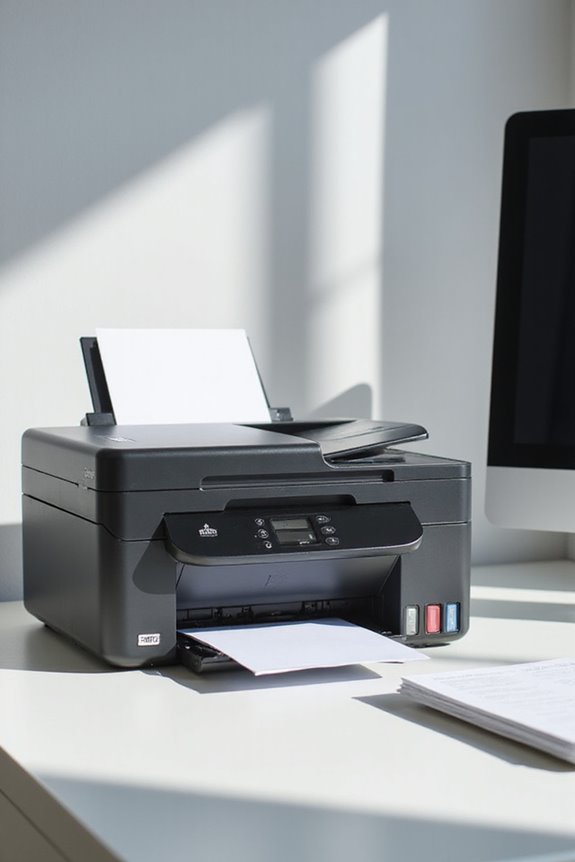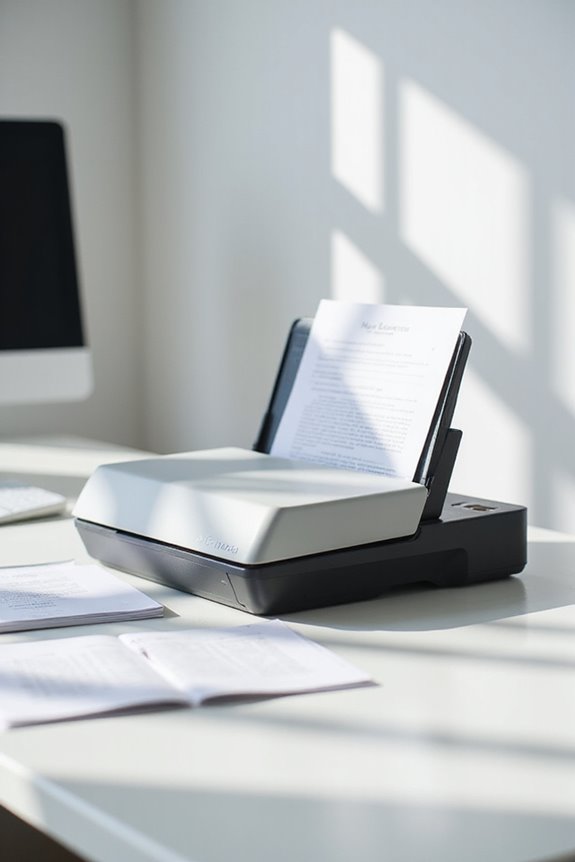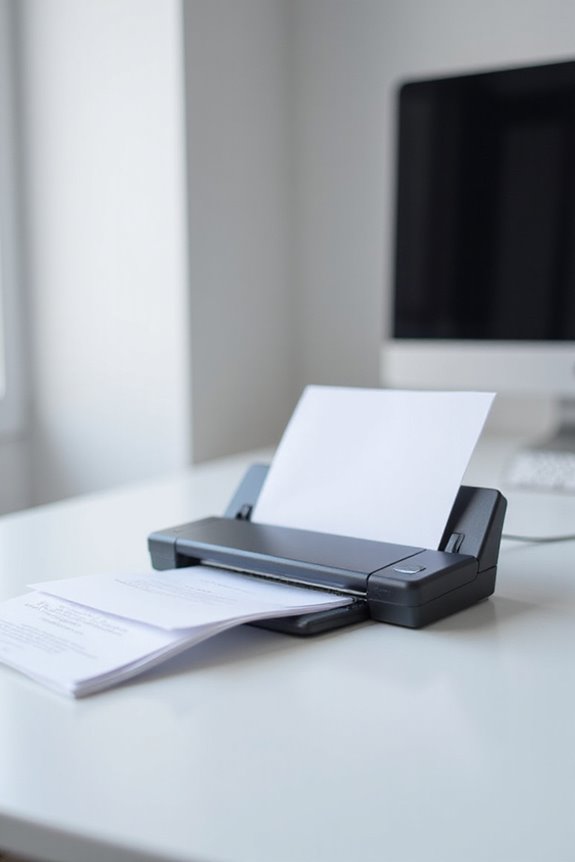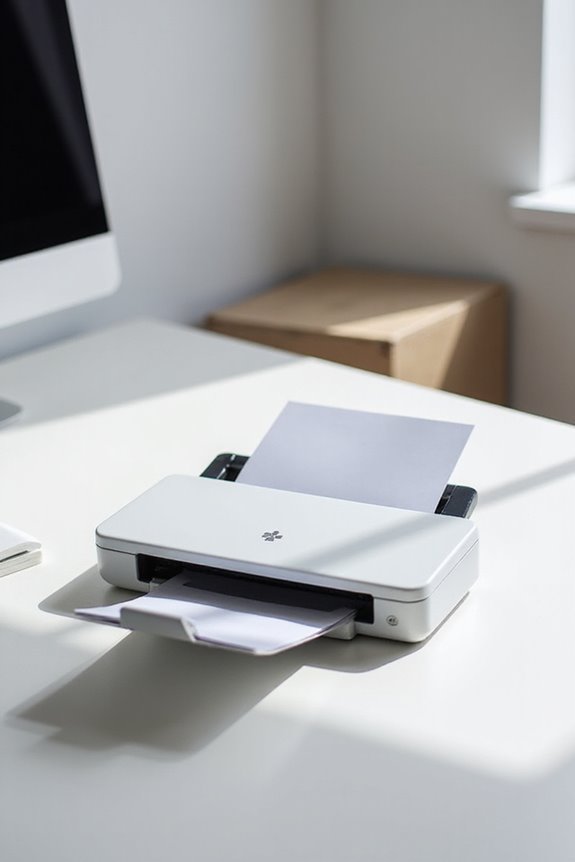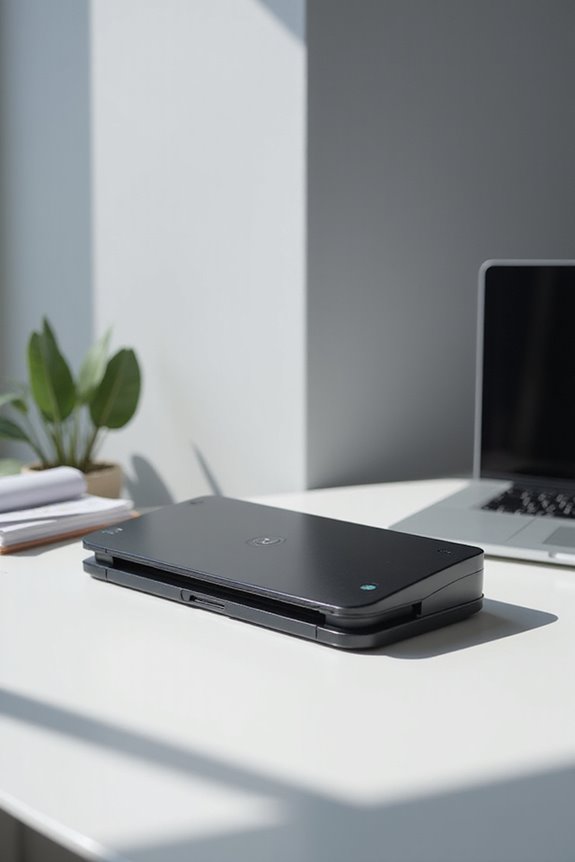To use the Epson EcoTank scanner printer, we’ll start by setting it up, ensuring it’s connected to power and initialized correctly. We should prioritize ink tank management by regularly checking levels and using original Epson ink. For scanning, we can utilize the Auto Document Feeder for efficiency and save files in various formats. By using the Epson Scan 2 app, we can easily adjust settings and enhance our documents. There’s much more to explore for ideal use.
Key Takeaways
- Start by setting up the printer: connect power, press the power button, and ensure all packaging materials are removed.
- Manage ink tanks effectively by regularly checking levels, refilling with original Epson ink, and cleaning spills with a cloth.
- Utilize the Auto Document Feeder (ADF) for quick scanning of multiple pages, placing documents face down on the scanner glass.
- Use the Epson Scan 2 app to select the scanner, adjust settings, and save scanned files in PDF or JPEG formats.
- Conduct regular maintenance to prevent paper jams and ensure optimal performance, including cleaning print heads and monitoring ink levels.
Hardware Setup
When setting up your Epson EcoTank printer, it’s vital to follow the hardware setup steps carefully to guarantee peak performance. First, we need to connect the included power cable to the printer’s rear port and plug it into a power outlet. After pressing the power button, let’s wait for the printer to initialize. Don’t forget to adjust the control panel, which may tilt up to 90° for better visibility.
Next, we’ll remove all packaging materials from the scanner bed and other components before closing it gently. Ensuring that the scanner unit and ink tank cover are securely closed is essential for maximum functionality. Additionally, make sure to consider the scanning performance and efficiency of your device to optimize your workflow. Finally, we can connect the printer to our computer for seamless use once the hardware setup is complete.
Ink Tank Management

Effective ink tank management is essential for guaranteeing our Epson EcoTank printer runs smoothly and efficiently. To maintain peak performance, we must prioritize ink tank maintenance and regular refilling. When replacing ink tanks, we should open the tank cover carefully, release the empty tank, and use a clean cloth to catch any spills. It’s vital to refill tanks without overfilling and to only use original Epson ink for the best results. Before starting, we need to turn on the printer to access the maintenance menu. Regularly monitoring ink levels allows us to prevent unexpected outages, while keeping the printer clean and updated promotes longevity. Additionally, understanding ink compatibility is crucial to ensure optimal functioning of your printer. Following these steps will keep our EcoTank operational and reliable for our printing needs.
Scanner Functionality
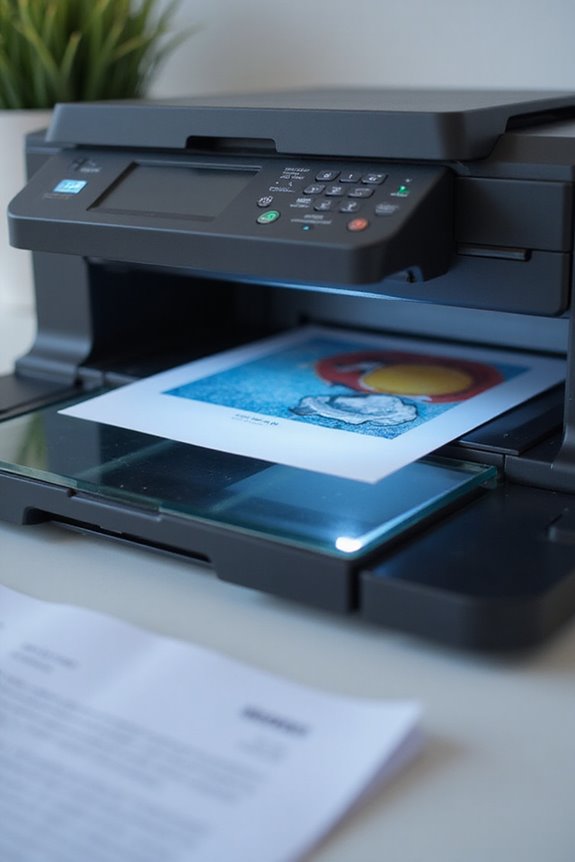
Understanding the scanner functionality of the Epson EcoTank printer allows us to maximize its capabilities for both document and photo scanning. This printer includes several useful scanner features, like an Auto Document Feeder (ADF) for scanning multiple pages in one go, enhancing efficiency. To achieve high document quality, we should place documents face down on the scanner glass, guaranteeing they’re aligned correctly to avoid cropping. Selecting the right scan settings is vital; for example, a resolution of 600 DPI captures fine details in images, while 200 DPI suffices for text. By saving scanned files in formats like PDF or JPEG, we facilitate easy access and shareability, making scanning streamlined and effective for our various needs. Additionally, utilizing features like Digital ICE technology can help enhance the quality of scanned images by removing dust and scratches.
Using the Epson Scan 2 App
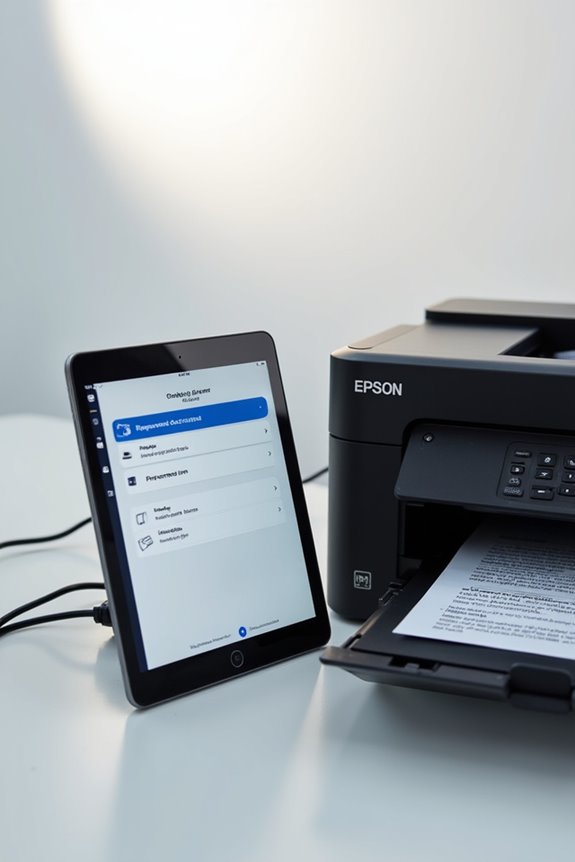
The Epson Scan 2 app is a powerful tool for maximizing the scanning capabilities of your Epson EcoTank printer. With this intuitive software, we can easily select our scanner, adjust basic settings, and choose scanning methods tailored to our tasks. It features scan presets designed for different document types, allowing us to create and save custom options for quick access. This not only saves time but enhances our productivity. Plus, the advanced settings provide us with color management and detailed image adjustments to meet our specific needs. We can preview scans and organize files effectively, ensuring a streamlined workflow. By exploring these features, we can greatly improve our scanning experience and efficiency. Additionally, utilizing image quality settings can ensure we achieve the best results based on our specific document types.
Printing Options
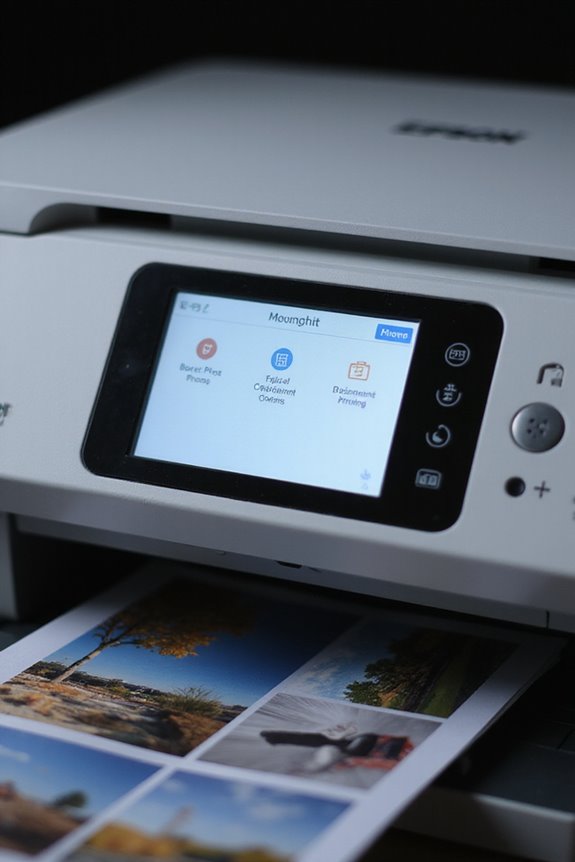
After maximizing our scanning potential with the Epson Scan 2 app, it’s time to explore the printing options that the Epson EcoTank printer offers. We can choose between two dpi settings: 300 dpi for quick prints and 600 dpi for high-quality output. The higher dpi provides sharper, more precise results, but remember that it may slow down printing speed. Depending on our needs, we can select color modes, printing in vibrant color or classic black and white. Additionally, the print dialog allows us to specify media type and size, ensuring ideal results. With automatic color management and options for duplex printing, we have the flexibility to finalize our projects efficiently while maintaining quality. Furthermore, the scanning speed of up to 35 pages per minute enhances our overall productivity when managing print tasks.
Scanning Multiple Pages
Scanning multiple pages efficiently can greatly enhance our productivity, especially when dealing with extensive documents. For those with models equipped with an Automatic Document Feeder (ADF), we can simply load our pages and select ADF-Single or Double-sided mode in the Epson Scan software. This allows for quick multipage scanning without manual effort. If we’re using a model without ADF, we’ll need to scan each page individually, saving each before placing the next one down. Once scanned, we can utilize document organization tips within the editing interface, allowing us to reorder or delete pages as necessary. Additionally, models like the Epson V600 Scanner are ideal for preserving high-quality images during the scanning process. Ultimately, mastering these multipage scanning techniques will streamline our workflow and create neat, combined PDFs ready for sharing or archiving.
Maintenance and Troubleshooting
Maintaining and troubleshooting our Epson EcoTank printer is essential to guarantee peak performance and longevity. Regular printer maintenance will help us avoid issues like paper jams and misfeeds. We should clean the exterior and verify dust-free storage to protect our printer. Performing internal cleaning routines, such as print head maintenance and nozzle checks, can greatly improve print quality. If we encounter common problems, we can apply troubleshooting tips like gently removing jammed paper or resetting network settings for connectivity issues. Additionally, monitoring ink levels and promptly replacing the maintenance box when needed prevents leaks and costly repairs. By staying proactive with maintenance, we can enjoy efficient printing and extend our printer’s lifespan.
Software Updates and Compatibility
To guarantee our Epson EcoTank printer performs at its best, we must regularly update its software and verify compatibility with our devices. We can check for software updates easily via the Control Panel on Windows, making sure we have the latest features and improvements. The Epson Scan 2 application is essential for our scanning needs, and its compatibility with our operating system is vital to prevent compatibility issues. We should also verify that our printer drivers are in sync with our computers, especially for wireless functionality. By regularly updating through the Epson Software Updater, we can enhance our experience and prevent issues. Let’s remember to allow the updater system changes and complete installations fully for uninterrupted use.
Frequently Asked Questions
Can I Print Directly From My Smartphone?
Just like a painter finds inspiration anywhere, we can print directly from our smartphones. With great mobile printing capabilities and solid smartphone compatibility, we can easily capture moments on paper whenever creativity strikes!
What Types of Paper Are Recommended for Printing?
When printing, we’ve found that using high-quality photo paper is essential for vibrant images. Additionally, for our cardstock options, selecting the right thickness guarantees crisp results—let’s explore various types to enhance our prints!
How Do I Find the Printer’S IP Address?
To find our printer’s IP address, we can check the printer settings under network configuration. Alternatively, we could print a network status page or use the Epson iPrint app for quick access.
Is the Printer Compatible With Linux Operating Systems?
Coincidentally, we’ve found that many Epson EcoTank printers lack official Linux compatibility. However, open source drivers might help us bridge the gap, enabling basic functionalities despite some limitations encountered with specific models along the way.
Can I Use Third-Party Ink in My Ecotank Printer?
Yes, we can use third-party ink in our EcoTank printer, but we should consider third-party compatibility and ink quality. While cost-effective, sometimes performance can vary, so let’s weigh our options carefully before using them.

